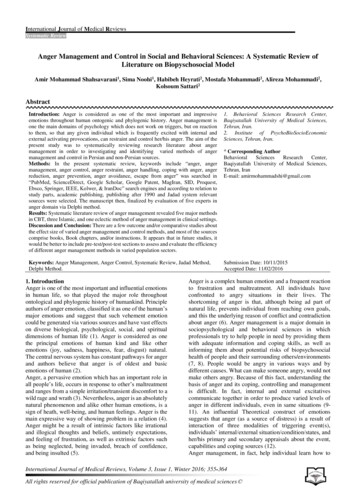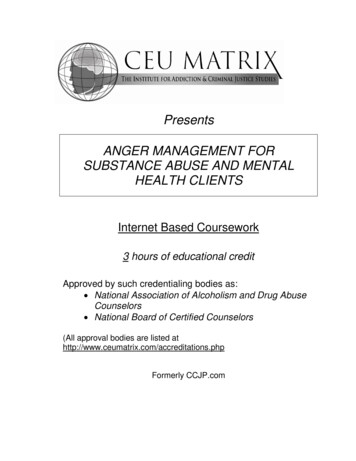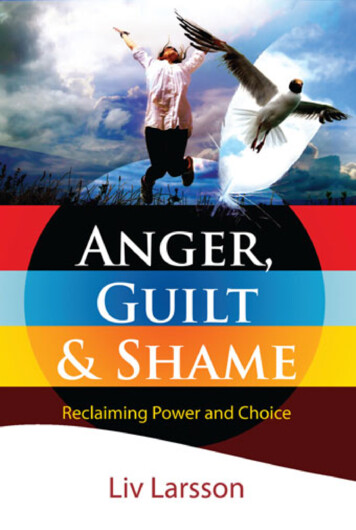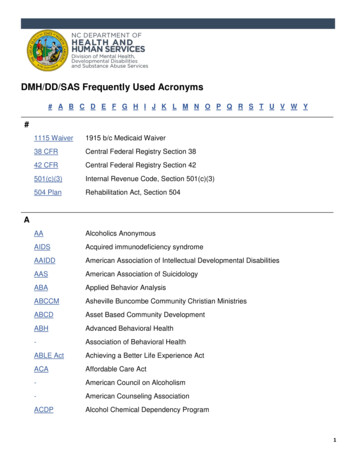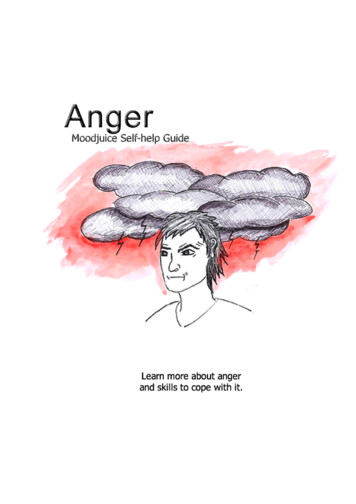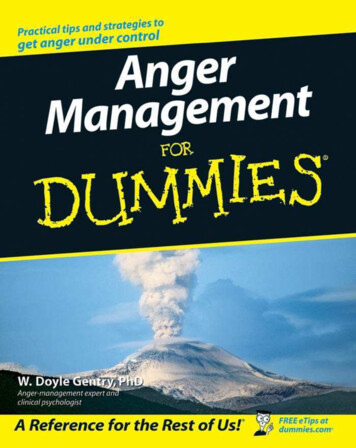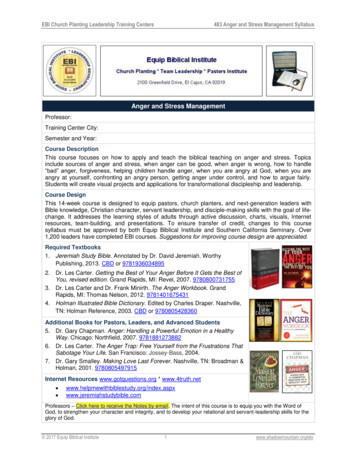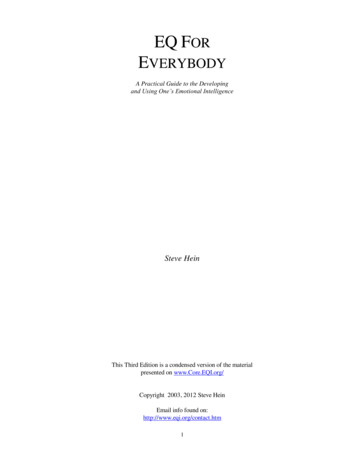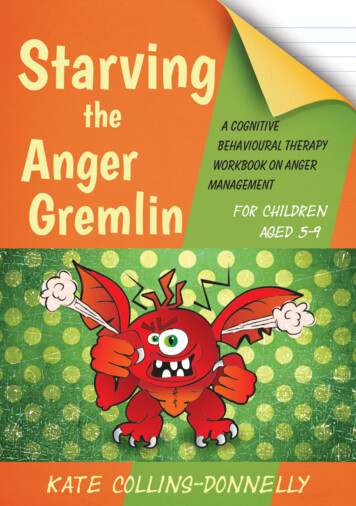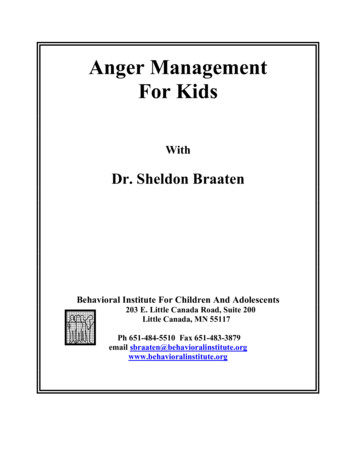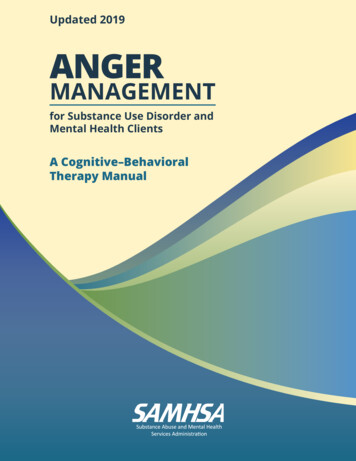
Transcription
Updated 2019ANGERMANAGEMENTfor Substance Use Disorder andMental Health ClientsA Cognitive–BehavioralTherapy Manual
This page intentionally left blank
Anger Managementfor Substance Use Disorder and Mental Health ClientsA Cognitive–Behavioral Therapy ManualUPDATED 2019Patrick M. Reilly, Ph.D.Michael S. Shopshire, Ph.D.U.S. DEPARTMENT OF HEALTH AND HUMAN SERVICESSubstance Abuse and Mental Health Services AdministrationCenter for Substance Abuse Treatment5600 Fishers LaneRockville, MD 20857
ANGER MANAGEMENT for Substance Use Disorder and Mental Health ClientsAcknowledgmentsNumerous people contributed to the development of this manual (see appendix). The publication waswritten by Patrick M. Reilly, Ph.D., and Michael S. Shopshire, Ph.D., of the San Francisco Treatment ResearchCenter. Sharon Hall, Ph.D., was the Treatment Research Center’s Principal Investigator.This publication is, in part, a product of research conducted with support from the National Institute onDrug Abuse, Grant DA 09253, awarded to the University of California–San Francisco. The research for thispublication was also supported by funding from the Department of Veterans Affairs to the San FranciscoVeterans Affairs Medical Center. This publication was updated under contract number 270-14-0445 by theKnowledge Application Program (KAP) for the Substance Abuse and Mental Health Services Administration(SAMHSA), U.S. Department of Health and Human Services (HHS). Suzanne Wise served as the ContractingOfficer’s Representative, and Candi Byrne served as Alternate Contracting Officer’s Representative. DarrickD. Cunningham, LCSW, BCD, and Arlin Hatch, CDR, USPHS, Ph.D., served as the Product Champions.DisclaimerThe views, opinions, and content expressed herein are the views of the authors and do not necessarily reflectthe official position of SAMHSA. No official support of or endorsement by SAMHSA for these opinions or forthe instruments or resources described is intended or should be inferred. The guidelines presented shouldnot be considered substitutes for individualized client care and treatment decisions.Public Domain NoticeAll materials appearing in this volume except those taken directly from copyrighted sources are in the publicdomain and may be reproduced or copied without permission from SAMHSA or the authors. Citation of thesource is appreciated. However, this publication may not be reproduced or distributed for a fee without thespecific, written authorization of the Office of Communications, SAMHSA.Electronic Access and Copies of PublicationThis publication may be downloaded or ordered at https://store.samhsa.gov or by calling SAMHSA at1-877-SAMHSA-7 (1-877-726-4727) (English and Español).Recommended CitationReilly, P.M., & Shopshire, M.S. Anger Management for Substance Use Disorder and Mental Health Clients: ACognitive–Behavioral Therapy Manual. SAMHSA Publication No. PEP19-02-01-001. Rockville, MD: SubstanceAbuse and Mental Health Services Administration, 2019.Originating OfficeQuality Improvement and Workforce Development Branch, Division of Services Improvement, Center forSubstance Abuse Treatment, Substance Abuse and Mental Health Services Administration, 5600 FishersLane, Rockville, MD 20857, SAMHSA Publication No. PEP19-02-01-001.Nondiscrimination NoticeSAMHSA complies with applicable federal civil rights laws and does not discriminate on the basis of race,color, national origin, age, disability, or sex. SAMHSA cumple con las leyes federales de derechos civilesaplicables y no discrimina por motivos de raza, color, nacionalidad, edad, discapacidad, o sexo.SAMHSA Publication No. PEP19-02-01-001First Printed 2002Updated 2019II
A Cognitive–Behavioral Therapy ManualFOREWORDAnger and substance use disorders often co-occur, increasing the risk for negative consequencessuch as physical aggression, self-harm, distressed relationships, loss of a job, or criminaljustice involvement. According to a 2014 meta-analysis of 23 studies, nearly half of people whocommitted homicides were under the influence of alcohol and 37 percent were intoxicated(Kuhns, Exum, Clodfelter, & Bottia, 2014). Anger, violence, and associated traumatic stresscan often correlate with the initiation of drug and alcohol use and can be a consequence ofsubstance use. Individuals who experience traumatic events, for example, may experience angerand act violently, as well as misuse drugs or alcohol.Clinicians often see how anger and violence and substance use are linked (Shopshire & Reilly, 2013).Many clients with substance use and mental health issues experience traumatic life events, which,in turn, lead to substance use, anger, and increased risk for violence. Meta-analyses have reliablydemonstrated the efficacy of cognitive–behavioral therapy in the treatment of addictions and othermental health issues, such as depression, traumatic stress, and anxiety.To provide clinicians with tools to help deal with this important issue, the Center for SubstanceAbuse Treatment at the Substance Abuse and Mental Health Services Administration is pleasedto present revised and updated versions of Anger Management for Substance Use Disorder andMental Health Clients: A Cognitive–Behavioral Therapy Manual and its companion book AngerManagement for Substance Use Disorder and Mental Health Clients: Participant Workbook, whichwere originally published in 2002.The anger management treatment design in this manual, which has been delivered to thousandsof clients over the past three decades, has been popular with both clinicians and clients.This format of the manual lends itself to use in a variety of clinical settings; can be adaptedto accommodate different racial-ethnic minority groups and genders, and diverse treatmentsettings; and will be a helpful tool for the field.Elinore F. McCance-Katz, M.D., Ph.D.Assistant Secretary for Mental Health and Substance UseSubstance Abuse and Mental Health Services AdministrationIII
This page intentionally left blank
A Cognitive–Behavioral Therapy ManualCONTENTSForeword . . . . . . . . . . . . . . . . . . . . . . . . . . . . . . . . . . . . . . . . . . . . . . . . . . . . . . . . . . . . . . . . . . . . . . iiiIntroduction . . . . . . . . . . . . . . . . . . . . . . . . . . . . . . . . . . . . . . . . . . . . . . . . . . . . . . . . . . . . . . . . . . . . 1How To Use This Manual . . . . . . . . . . . . . . . . . . . . . . . . . . . . . . . . . . . . . . . . . . . . . . . . . . . . . . . . 5Session 1 Overview of Group Anger Management Treatment . . . . . . . . . . . . . . . . . . . . . . . . . . . . 7Session 2 Events and Cues: A Conceptual Framework for Understanding Anger . . . . . . . . . . . . 15Session 3 Anger Control Plans: Helping Group Members Develop a Planfor Controlling Anger . . . . . . . . . . . . . . . . . . . . . . . . . . . . . . . . . . . . . . . . . . . . . . . . . . . . 21Session 4 The Aggression Cycle: How To Change the Cycle . . . . . . . . . . . . . . . . . . . . . . . . . . . . . 27Session 5 Cognitive Restructuring: The A-B-C-D Model and Thought Stopping . . . . . . . . . . . . . 33Session 6 Practice Session #1: Reinforcing Learned Concepts . . . . . . . . . . . . . . . . . . . . . . . . . . . 37Sessions 7 & 8 Assertiveness Training and the Conflict Resolution Model:Alternatives for Expressing Anger . . . . . . . . . . . . . . . . . . . . . . . . . . . . . . . . . . . . . 39Sessions 9 & 10 Anger and the Family: How Past Learning CanInfluence Present Behavior . . . . . . . . . . . . . . . . . . . . . . . . . . . . . . . . . . . . . . . . . 45Session 11 Practice Session #2: Reinforcing Learned Concepts . . . . . . . . . . . . . . . . . . . . . . . . . . 49Session 12 Closing and Graduation: Closing Exercise and Awarding of Certificates . . . . . . . . . . 51References . . . . . . . . . . . . . . . . . . . . . . . . . . . . . . . . . . . . . . . . . . . . . . . . . . . . . . . . . . . . . . . . . . . . 53Appendix Authors’ Acknowledgments . . . . . . . . . . . . . . . . . . . . . . . . . . . . . . . . . . . . . . . . . . . . . . 57V
This page intentionally left blank
A Cognitive–Behavioral Therapy ManualINTRODUCTIONThis manual, which was originally published in 2002 and has been revised and updated for thecurrent edition, was designed for use by clinicians who work with clients who have substanceuse and mental health problems co-occurring with anger management problems. In addition, ithas been used by individuals for self-paced study outside of a group counseling setting (e.g., byindividuals who are incarcerated). The manual describes a 12-week cognitive–behavioral angermanagement group treatment model. Each of the 12, 90-minute weekly sessions is describedin detail with specific instructions for group leaders, tables and exhibits that illustrate the keyconceptual components of the treatment, and between-session challenges for group members.The accompanying participant workbook (see Anger Management for Substance Use Disorderand Mental Health Clients: Participant Workbook; Reilly, Shopshire, Durazzo, & Campbell, 2019)has been updated to correspond with the updated manual. It should be used in conjunctionwith this manual to enable group members to better learn, practice, and integrate the treatmentstrategies presented in the manual. This intervention was developed for studies at the SanFrancisco Veterans Affairs (SFVA) Medical Center and San Francisco General Hospital (now knownas the Priscilla Chan and Mark Zuckerberg San Francisco General Hospital and Trauma Center[Zuckerberg San Francisco General Hospital]).Cognitive–behavioral therapy (CBT) has been found to be an effective, time-limited treatmentfor anger problems (Fernandez, Malvaso, Day, & Guharajan, 2018; Henwood, Chou, & Browne,2015). Four types of CBT interventions, theoretically unified by principles of social learningtheory, are most often used when treating anger management problems: Relaxation training targets emotional and physiological components of anger. Cognitive interventions target cognitive processes such as building awareness of cues andtriggers, hostile appraisals and attributions, maladaptive beliefs, and inflammatory thinking.(The manual uses the term “trigger” because it will be a familiar concept to group memberswho have gone through substance use disorder treatment. The term “trigger” is not meantto convey that anger is an automatic response that cannot be controlled.) Communication skills interventions target strengthening assertiveness and conflictresolution skills. Combined interventions integrate two or more CBT interventions and target multipleresponse domains.Meta-analyses and reviews of the literature (Fernandez et al., 2018; Henwood et al., 2015),including studies of prison populations, conclude that there are clinically significant anger reductioneffects as a result of CBT interventions. The treatment model described in this manual is acombined CBT approach that employs relaxation, cognitive, and communication skills interventions.This combined approach presents group members with options that draw on these differentinterventions and then encourages them to develop an individualized anger control plan using asmany techniques as possible. Not all group members will use all the techniques and interventionsIntroduction1
presented in the treatment (e.g., cognitive restructuring), but almost all will finish the treatmentwith more than one technique or intervention in their anger control plans.Theoretically, the more techniques and interventions an individual has in his or her anger control plan,the better equipped he or she will be to manage anger in response to anger-provoking events.In studies at the SFVA Medical Center and the Zuckerberg San Francisco General Hospital usingthis treatment model, significant reductions in self-reported anger and violence have consistentlybeen found, as well as decreased substance use (Reilly, Clark, Shopshire, & Delucchi, 1995; Reilly& Shopshire, 2000). Most participants in these studies met Diagnostic and Statistical Manual ofMental Disorders, Fourth Edition (DSM-IV) (American Psychiatric Association [APA], 1994), criteriafor substance dependence and would meet the criteria for substance use disorder as updated inDSM-5 (APA, 2013).The overall treatment model is flexible; can accommodate racial, cultural, and gender issues;and was found to be effective with different racial-ethnic minority groups and with both menand women (Reilly & Shopshire, 2000). In the anger management studies using this manual, themajority of patients were from racial-ethnic minority groups. The events or situations associatedwith someone’s anger may vary somewhat depending on his or her culture or gender. The cuesor warning signs of anger may vary in this regard as well. A person still has to identify the eventthat led to anger, recognize the cues to anger, and develop anger management (cognitive–behavioral) strategies in response to the event and cues, regardless of whether these events andcues are different for other men and women or for people in other cultural groups.In addition to the studies in San Francisco, Morland et al. (2010) studied 125 veterans withpost-traumatic stress disorder (PTSD) and anger control problems from three Veterans HealthAdministration clinical sites and three Vet Centers in Hawaii. Participants were randomlyassigned to receive the anger management treatment either in face-to-face sessions or overvideoconference equipment. Regardless of mode of presentation, participants reduced theirlevels of anger significantly, suggesting that people can achieve significant reductions in angerlevels using many different modes of presentation. Ninety percent of participants completedanger management treatment. Similar to findings from studies at the SFVA Medical Center (Reillyet al., 1995), greater PTSD symptom severity had higher anger levels at baseline, but higherlevels of PTSD symptoms did not predict greater anger symptom reductions. Mackintosh et al.(2014) attempted to identify participants who achieved the greatest decrease in anger levels, butpatients showed similarly lower levels of anger across a range of psychosocial, racial-ethnic, andpsychiatric variables.A study by Zarshenas, Baneshi, Sharif, and Sarani (2017) suggests the anger managementtreatment described in this manual may produce clinically significant reductions in levels ofanger with participants in other countries. Zarshenas et al. used a quasi-experimental designwith a sample of 36 patients at Ebnesina Hospital, in Shiraz, Iran. The group receiving the angermanagement treatment did not differ from the comparison condition with regard to age,marital status, education level, or substance of choice. Anger and aggression were measuredwith a questionnaire developed by Buss and Perry (1992). Anger and aggression decreasedsignificantly for participants who received the anger management treatment but increased forthe comparison group.2Introduction
A Cognitive–Behavioral Therapy ManualA study by Walitzer, Deffenbacher, and Shyhalla (2015) further illustrates the usefulness ofanger management treatments for individuals with substance use disorders. They conducted arandomized controlled trial comparing a 12-session alcohol-adapted anger management treatmentsimilar to the one in this treatment manual with a 12-Step facilitation treatment. The angermanagement treatment focused on monitoring cues to anger arousal, relaxation training, andcognitive restructuring. Participants were encouraged to use these anger management strategies tocope with anger-related events that could increase the risk of alcohol use or relapse. Participants inboth conditions decreased their levels of anger, but in the anger management treatment condition,people who lowered their levels of anger were less likely to experience negative alcohol-relatedconsequences, such as taking foolish risks or damaging a friendship or close relationship.The intervention involves developing individualized anger control plans. For example, somewomen identified their relationships with their partners or parenting concerns as events thatled to their anger, but men rarely identified these issues. Effective individual strategies couldbe developed to address these issues, provided the women accept the concepts of monitoringanger (using the anger meter and the anger awareness record) and having (and using) an angercontrol plan.This treatment model was also used successfully with clients who were not abusing substancesseen in the outpatient SFVA Mental Health Clinic. These clients were diagnosed with a variety ofproblems, including mood, anxiety, and thought disorders. The treatment components describedin this manual served as the core treatment in these studies.The anger management treatment was designed to be delivered in a group setting. The idealnumber of participants in a group is 8, but groups can range from 5 to 10 members. There areseveral reasons for this recommendation. First, solid empirical support exists for group cognitive–behavioral interventions (Cuijpers, Cristea, Karyotaki, Reijnders, & Huibers, 2016; Owen,Sellwood, Kan, Murray, & Sarsam, 2015); second, group treatment is efficient and cost-effective(Hoyt, 1993; Piper & Joyce, 1996); and third, it provides a greater range of possibilities andflexibility in roleplays (Yalom, 1995) and behavioral rehearsal activities (Heimberg & Juster, 1994;Juster & Heimberg, 1995). Counselors and social workers should have training in CBT, grouptherapy, and substance use disorder treatment.Although a group format is recommended for the anger management treatment, it is possiblefor qualified clinicians to use this manual in individual sessions with their clients (Awalt, Reilly, &Shopshire, 1997). In this case, the same treatment format and sequence can be used. Individualsessions provide more time for indepth instruction and individualized behavioral rehearsal. Reportsfrom practitioners have also established that the manual and workbook have been used for selfstudy, without the support of a clinician or a group. Although there has been no research into thevalidity of this use of the manual, anecdotal reports indicate that individuals have had success with it.The anger management treatment manual is designed for adults (ages 18 and older) who havesubstance use and mental health conditions. The groups studied at SFVA Medical Center and theZuckerberg San Francisco General Hospital have included patients who have used many substances(e.g., cocaine, alcohol, heroin, methamphetamine). These patients used the anger managementmaterials and benefited from the group treatment, despite differences in their primary drug of choice.Introduction3
It is recommended that group members be abstinent from drugs (except for properly usedprescription medications) and alcohol for at least 2 weeks before joining the anger managementgroup. If a participant in the San Francisco treatment groups had a “slip” during his or herenrollment in the group, he or she was not discharged from the group. However, if he or shehad repeated slips or a relapse, the individual was referred to a more intensive treatment settingand asked to start the anger management treatment again. Group leaders may consider thepossible risk-reduction benefits of people participating in this treatment who are not abstinent,as clinically indicated.Many group members were diagnosed with co-occurring disorders (e.g., PTSD, mood disorder,psychosis) and still benefited from the anger management group treatment. Patients werecompliant with their psychiatric medication regimen and were monitored by interdisciplinarytreatment teams. The San Francisco group found that, if patients were compliant with theirmedication regimen and abstinent from drugs and alcohol, they could comprehend thetreatment material and effectively use concepts such as timeouts and thought stopping tomanage anger. However, if a group member had a history of severe mental illness, did not complywith instructions on his or her psychiatric medication regimen, and had difficulty processing thematerial or accepting group feedback, he or she was referred to his or her psychiatrist for bettermedication management.Because of the many problems often experienced by clients with substance use and mental healthconditions, this intervention should be used as an adjunct to treatment for substance use andmental disorders. Certain issues, such as anger related to clients’ family of origin and past learning,may best be explored in individual and group therapy outside the anger management group.Finally, the authors stress the importance of providing ongoing anger management aftercaregroups. Participants at the SFVA Medical Center repeatedly asked to attend aftercare groupswhere they could continue to practice and integrate the anger management strategies theylearned in this treatment. At the SFVA Medical Center, both an ongoing drop-in group and a morestructured 12-week phase-two group were provided as aftercare components. These groupshelped participants maintain (and further reduce) the decreased level of anger and aggressionthey achieved during the initial 12-week anger management group treatment. Participants canalso be referred to anger management groups in the community.It is hoped that this anger management manual will help clinicians who treat substance use andmental disorders provide effective anger management treatment to clients who experience angerproblems. Reductions in frequent and intense anger and its destructive consequences can lead toimproved physical and mental health of individuals and families.4Introduction
A Cognitive–Behavioral Therapy ManualHOW TO USE THIS MANUALThe information presented in this manual is intended to allow professionals who treatclients with mental and substance use disorders to deliver group cognitive–behavioral angermanagement treatment. With the exception of session 12 (which is a graduation and awardceremony), the chapter for each 90-minute weekly session is divided into four sections: Instructions to Group Leaders Check-In Procedure (beginning in the second session) Suggested Remarks Between-Session ChallengeThe Instructions to Group Leaders section summarizes the information to be presented in thesession and outlines the key conceptual components. The Check-In Procedure section providesa structured process by which group members report on the progress of their between-sessionchallenges from the previous week. The Suggested Remarks section provides narrative scriptsfor the group leader presenting the material in the session. Although the group leader is notrequired to read the scripts verbatim, the group leader should deliver the information asclosely as possible to the way it is in the script. The Between-Session Challenge section providesinstructions for group members on what tasks to review and practice for the next meeting.Session 1 also includes a special section that provides an overview of the anger managementtreatment and outlines the group rules.This manual should be used in conjunction with the Anger Management for Substance UseDisorder and Mental Health Clients: Participant Workbook (Reilly et al., 2019). The workbookprovides group members with a summary of the information presented in each session,worksheets for completing between-session challenges, and space to take notes during eachsession. The workbook facilitates the completion of between-session challenges and reinforcesthe concepts presented over the course of the anger management treatment program.Although group members are kept busy in each session, 90 minutes should be enough timeto complete the tasks at hand. Most sessions include prompts to engage members, but groupleaders should feel free to elicit input from the group more frequently. The group leader needs tomonitor and may, at times, need to limit the responses of members, however. This can be doneby redirecting them to the question or activity.In practice, some individuals have opted to use this manual for self-directed learning: clarifyingtheir needs, setting goals, learning new information, and choosing and implementing strategies.While a person’s motivation and willingness to undertake self-improvement are encouraging,little research has been done on how self-directed learning relates to actual behavior change inanger management.How To Use This Manual5
This page intentionally left blank
A Cognitive–Behavioral Therapy ManualOVERVIEW OF GROUP ANGER MANAGEMENT TREATMENTSession 1Instructions to Group LeadersIn the first session, the leader presents the purposeand overview of the 12 sessions, the group rules, andthe conceptual framework and rationale for angermanagement treatment. Most of this session is spentpresenting conceptual information. Because thereis a lot of information to communicate, the leadershould pause periodically to engage group membersin conversation and verify that they understandthe concepts. The session concludes with a groupexercise in awareness building and a presentation ofthe anger meter (see Exhibit 1, page 13).Outline of Session 1 Instructions to Group LeadersSuggested Remarks– Purpose and Overview– Group Rules– The Problem of Anger: SomeOperational Definitions– When Does Anger Become aProblem?– Payoffs and Consequences– Myths About Anger– Anger as a Habitual Response– Changing the Anger Habit– Participant Discussion– Anger MeterBetween-Session ChallengeThe leader starts the first session by introducinghimself or herself and asking group members toshare their name, the reasons they are interestedin participating in the anger management group,and what they hope to achieve in the group. Aftera member introduces himself or herself, the leader offers a supportive comment that validates themember’s decision to participate in the group.Experience shows that this helps members feel the group will meet their needs and reduces theanxiety associated with the introductions and the first group session in general.Suggested Remarks(Use the following script or put it in your own words.)Purpose and OverviewThe purpose of the anger management group is to: Learn to manage anger. Stop violence or the threat of violence. Develop and strengthen skills for self-control over thoughts and actions. Receive support and feedback from others.Group Rules1. Group Safety. No violence or threats toward staff and other group members are allowed. Itis important that you perceive the group as a safe place to share your experiences and feelingswithout threats or possible physical harm.SESSION 17
ANGER MANAGEMENT for Substance Use Disorder and Mental Health Clients2. Confidentiality. You should not discuss outside the group what other group members sayduring group sessions. There are limits to confidentiality, however. In every state, health lawsgovern how and when professionals must report certain actions to the proper authorities. Theseactions may include any physical or sexual abuse inflicted on a child or adolescent younger thanage 18, a person age 65 or older, or a dependent adult. A dependent adult is someone betweenages 18 and 64 who has physical or mental limitations that restrict his or her ability to carry outnormal activities or to protect his or her rights. Reporting abuse of these persons supersedesconfidentiality laws involving clients and health professionals. Similarly, if a group member makescredible threats to physically harm or kill another person, the group leader is required, under theTarasoff ruling, to warn the intended victim and notify the police.3. Between-Session Challenges. Brief assignments will be given each week. Doing the betweensession challenges will improve your anger management skills and allow you to get the most fromthe group experience. Like any type of skill acquisition, anger management requires time andpractice. These assignments provide the opportunity for skill development and refinement.4. Absences and Cancellations. You should call or notify the group leader in advance when youcannot attend a session. Because of the considerable amount of material presented in eachsession, you may not miss more than 3 of the 12 sessions. If you miss more than three sessions,you would not be able to adequately learn, practice, and apply the concepts and skills that arenecessary for effective anger management. You can continue to attend the group sessions, butyou will not receive a certificate of completion. You can join another session as space becomesavailable.5. Timeout. The group leader reserves the right to call for a timeout. You may be familiar withthe term timeout from sporting events. For example, when a football team feels it is not makingprogress, the team takes a timeout and regroup. We use this term in a similar way. If a groupmember’s anger begins to escalate out of control during a session, the leader will ask thatmember to take a timeout from the topic and the discussion. This means that the member,along with the rest of the group, will immediately stop talking about the issue that is causing themember’s anger to escalate. If the member’s anger has escalated to the point that he or shecannot tolerate sitting in the group, the leader may ask the person to leave the group for 5 or 10minutes or until he or she can cool down. The member is then welcomed back, provided he orshe can tolerate continued discussion in the group.A timeout is an effective anger management strategy and will be discussed in more detail laterin this session and in session 3. Eventually, you will learn to call a timeout yourself when you feelyou may be losing control as the result of escalation of your anger. For these sessions, however,it is essential that the leader calls for a timeout and that you comply with the rule. This ruleensures that the group will be a safe place to discuss and share experiences and feelings. Failureto comply with the timeout rule may lea
with more than one technique or intervention in their anger control plans. Theoretically, the more techniques and interventions an individual has in his or her anger control plan, the better equipped he or she will be to manage anger
